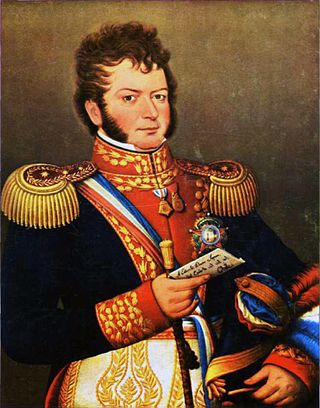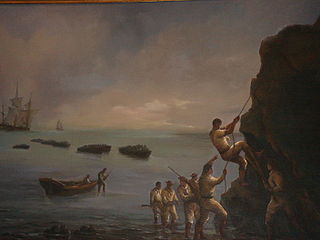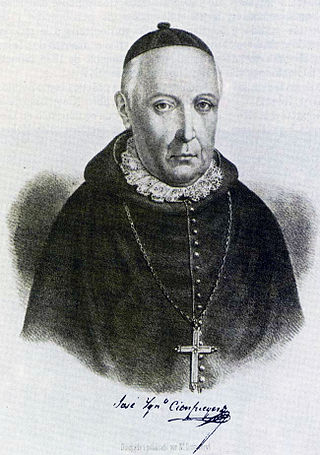
Bernardo O'Higgins Riquelme was a Chilean independence leader who freed Chile from Spanish rule in the Chilean War of Independence. He was a wealthy landowner of Basque-Spanish and Irish ancestry. Although he was the second Supreme Director of Chile (1817–1823), he is considered one of Chile's founding fathers, as he was the first holder of this title to head a fully independent Chilean state.

The Argentine War of Independence was a secessionist civil war fought from 1810 to 1818 by Argentine patriotic forces under Manuel Belgrano, Juan José Castelli, Martin Miguel de Guemes and José de San Martín against royalist forces loyal to the Spanish crown. On July 9, 1816, an assembly met in San Miguel de Tucumán, declaring independence with provisions for a national constitution.

The Battle of Maipú was fought near Santiago, Chile on 5 April 1818, between South American rebels and Spanish royalists, during the Chilean War of Independence. The Patriot rebels led by Argentine general José de San Martín effectively destroyed the Spanish forces commanded by General Mariano Osorio, and completed the independence of the core area of Chile from Spanish domination.

The Battle of Chacabuco, fought during the Chilean War of Independence, took place on February 12, 1817. The Army of the Andes, from the United Provinces of the Río de la Plata and led by Captain–General José de San Martín, defeated a Spanish force commanded by Rafael Maroto. This victory was a significant defeat for the Captaincy General of Chile, the royalist government established after the division of the Viceroyalty of Peru.

The Battle of Cancha Rayada, was fought in Chile between South American patriots and Spanish royalists, during the Osorio's campaign in the South American wars of independence. The result was a defeat for the patriot forces, weeks later the patriots take their rematch at the Battle of Maipú.
In the struggle for the independence of Spanish America, the Reconquista refers to the period of Colombian and Chilean history, following the defeat of Napoleon in 1814, during which royalist armies were able to gain the upper hand in the Spanish American wars of independence. The term used in the past century by some Colombian and Chilean historians makes an analogy to the medieval Reconquista, in which Christian forces retook the Iberian Peninsula from the Caliphate.

The Chilean War of Independence was a military and political event that allowed the emancipation of Chile from the Spanish Monarchy, ending the colonial period and initiating the formation of an independent republic.

The Capture of Valdivia was a battle in the Chilean War of Independence between Royalist forces commanded by Colonel Manuel Montoya and Fausto del Hoyo and the Patriot forces under the command of Thomas Cochrane and Jorge Beauchef, held on 3 and 4 February 1820. The battle was fought over the control of the city Valdivia and its strategic and heavily fortified harbour. In the battle Patriots gained control of the southwestern part of the Valdivian Fort System after an audacious assault aided by deception and the darkness of the night. The following day the demoralised Spanish evacuated the remaining forts, looted local Patriot property in Valdivia and withdrew to Osorno and Chiloé. Thereafter, Patriot mobs looted the property of local Royalists until the Patriot army arrived to the city restoring order.

Gabino Crispín Gaínza Fernández de Medrano was a Spanish military officer, knight of the Order of St. John and prominent politician in Spain's American colonies. He supported and declared independence on 15 September 1821 in the Kingdom of Guatemala, becoming the first ruler or president "jefe político superior" of a united and independent Central America extending from Soconusco through Guatemala, El Salvador, Honduras, Nicaragua and Costa Rica; leader of the Consultive Junta of Guatemala until its dissolution on 21 February 1822. During the Latin American wars of independence, he initially fought on the royalist side in Chile, becoming Royal Governor of Chile. He then became the last Captain General in the Kingdom of Guatemala on behalf of the King of Spain. After independence and the annexation to Mexico, he became the 1st Captain General of Central America on behalf of the Emperor of Mexico.
Clemente de Lantaño Pino was a royalist military officer during the Chilean War of Independence. Later, during the Spanish reconquest, he changed sides and fought for independence against the royalist forces.

Fr. José Ignacio Cienfuegos Arteaga was a Chilean priest, Roman Catholic bishop of Concepción and political figure. He served twice as President of the Senate of Chile.
Treaty of Lircay was a truce treaty agreed between the Royalist and the Patriot forces during the Chilean War of Independence.

Events from the year 1814 in Chile
The Battle of Les Tres Acequias, fought during the Chilean War of Independence, occurred near San Bernardo on 26 August 1814. The confrontation occurred between the two factions of Carrera and Bernardo O'Higgins, resulting in a defeat for O'Higgins that would in turn lead on to the defeat of the nationalists by the royalist forces at the battle of Rancagua a month later.
The first battle of Cancha Rayada, sometimes termed the 'Disaster' or 'Surprise of Cancha Rayada', took place on 29 March 1814, during the War of Chilean Independence.
The Capture of Talca, occurred on 3 March 1814, during the War of Chilean Independence.
The battle of Membrillar occurred on 20 March 1814, during the War of Chilean Independence.
The Battle of El Quilo, fought during the Chilean War of Independence, occurred at el Quilo, on the southern side of the Itata river, on 19 March 1814.

New Fatherland was a period in the history of Chile that began with the victory of Ejército de los Andes in the Battle of Chacabuco on 12 February 1817 and ended with the resignation of Bernardo O'Higgins as Supreme Director in 1823.
The following lists events that happened during 1818 in Chile.











